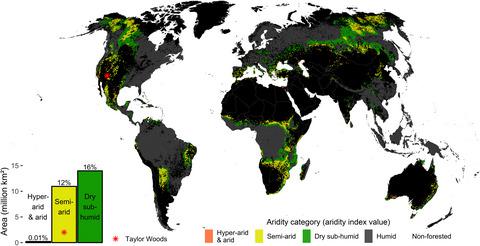当前位置:
X-MOL 学术
›
J. Appl. Ecol.
›
论文详情
Our official English website, www.x-mol.net, welcomes your feedback! (Note: you will need to create a separate account there.)
Low stand density moderates growth declines during hot-droughts in semi-arid forests
Journal of Applied Ecology ( IF 5.7 ) Pub Date : 2020-05-17 , DOI: 10.1111/1365-2664.13615 Caitlin M. Andrews 1 , Anthony W. D'Amato 2 , Shawn Fraver 3 , Brian Palik 4 , Michael A. Battaglia 5 , John B. Bradford 1
Journal of Applied Ecology ( IF 5.7 ) Pub Date : 2020-05-17 , DOI: 10.1111/1365-2664.13615 Caitlin M. Andrews 1 , Anthony W. D'Amato 2 , Shawn Fraver 3 , Brian Palik 4 , Michael A. Battaglia 5 , John B. Bradford 1
Affiliation

|
1. Increasing heat and aridity in coming decades is expected to negatively impact tree growth and threaten forest sustainability in dry areas. Maintaining low stand density has the potential to mitigate the negative effects of increasingly severe droughts by minimizing competitive intensity. 2. However, the direct impact of stand density on the growing environment (i.e. soil moisture), and the specific drought metrics that best quantify that environment, are not well explored for any forest ecosystem. We examined the relationship of varying stand density (i.e. basal area) on soil moisture and stand-level growth in a long-term (multi-decadal), ponderosa pine Pinus ponderosa, forest management experiment. We accounted for the influence of stand-level density on moisture availability by measuring and modelling soil moisture using an ecosystem water balance model. 3. To quantify the growing environment, we developed metrics of ecological drought that integrate the influence of moisture availability in the soil with moisture demand by the atmosphere. We paired these results with stand-level dendrochronological data, avoiding the potential bias introduced from individual tree-based assessments, and used critical climate period analysis to identify the timing and duration of these drought metrics that most relate to forest growth. 4. We found that stand-level growth is highly responsive to the combination of high temperature and low soil moisture. Growth in all stands was negatively related to temperature and positively related to moisture availability, although the sensitivity of growth to those conditions varied among stand density treatments. Growth enhancement during cool years is greatest in low density stands. In addition, low density stands displayed substantially higher long-term average growth than higher density stands and maintained higher growth even when temperatures were high. Growth in low density stands also increased more than higher density stands in response to greater long-term moisture availability. 5. Synthesis and applications. We quantified the influence of stand-level density on the environmental conditions that determine tree growth and related forest growth to patterns of moisture supply and demand. Our drought metrics, and analytical approach for quantifying drought impacts on forest growth, are a novel approach for assessing forest vulnerability to drought under climate change. These results provide new perspective on the potential for density management to mitigate drought stress and maintain forest stand growth during and after drought events in water-limited forests.
中文翻译:

低林分密度减缓了半干旱森林热干旱期间的生长下降
1. 预计未来几十年高温和干旱的增加将对树木生长产生负面影响,并威胁干旱地区森林的可持续性。保持低林分密度有可能通过最小化竞争强度来减轻日益严重干旱的负面影响。2. 然而,林分密度对生长环境(即土壤湿度)的直接影响,以及最能量化环境的具体干旱指标,对于任何森林生态系统都没有得到很好的探索。我们研究了不同林分密度(即基础面积)对土壤水分和林分水平生长的长期(多年)黄松松林管理试验的关系。我们通过使用生态系统水平衡模型测量和模拟土壤水分来考虑林分密度对水分可用性的影响。3. 为了量化生长环境,我们开发了生态干旱指标,将土壤中可用水分的影响与大气对水分的需求相结合。我们将这些结果与林分级别的树木年代学数据配对,避免了基于个体树木的评估引入的潜在偏差,并使用关键气候期分析来确定这些与森林生长最相关的干旱指标的时间和持续时间。4. 我们发现林分生长对高温和低土壤湿度的组合高度敏感。所有林分的生长与温度呈负相关,与水分可用性呈正相关,尽管生长对这些条件的敏感性因林分密度处理而异。低密度林分在凉爽年份的生长促进作用最大。此外,低密度林分的长期平均增长明显高于高密度林分,并且即使在温度较高的情况下也保持较高的增长。低密度林分的增长也比高密度林分增长更多,以应对更大的长期水分供应。5. 合成与应用。我们量化了林分密度对决定树木生长和相关森林生长对水分供需模式的环境条件的影响。我们的干旱指标和量化干旱对森林生长影响的分析方法,是一种评估气候变化下森林对干旱的脆弱性的新方法。这些结果为密度管理的潜力提供了新的视角,以减轻缺水森林的干旱压力并在干旱事件期间和之后维持林分生长。
更新日期:2020-05-17
中文翻译:

低林分密度减缓了半干旱森林热干旱期间的生长下降
1. 预计未来几十年高温和干旱的增加将对树木生长产生负面影响,并威胁干旱地区森林的可持续性。保持低林分密度有可能通过最小化竞争强度来减轻日益严重干旱的负面影响。2. 然而,林分密度对生长环境(即土壤湿度)的直接影响,以及最能量化环境的具体干旱指标,对于任何森林生态系统都没有得到很好的探索。我们研究了不同林分密度(即基础面积)对土壤水分和林分水平生长的长期(多年)黄松松林管理试验的关系。我们通过使用生态系统水平衡模型测量和模拟土壤水分来考虑林分密度对水分可用性的影响。3. 为了量化生长环境,我们开发了生态干旱指标,将土壤中可用水分的影响与大气对水分的需求相结合。我们将这些结果与林分级别的树木年代学数据配对,避免了基于个体树木的评估引入的潜在偏差,并使用关键气候期分析来确定这些与森林生长最相关的干旱指标的时间和持续时间。4. 我们发现林分生长对高温和低土壤湿度的组合高度敏感。所有林分的生长与温度呈负相关,与水分可用性呈正相关,尽管生长对这些条件的敏感性因林分密度处理而异。低密度林分在凉爽年份的生长促进作用最大。此外,低密度林分的长期平均增长明显高于高密度林分,并且即使在温度较高的情况下也保持较高的增长。低密度林分的增长也比高密度林分增长更多,以应对更大的长期水分供应。5. 合成与应用。我们量化了林分密度对决定树木生长和相关森林生长对水分供需模式的环境条件的影响。我们的干旱指标和量化干旱对森林生长影响的分析方法,是一种评估气候变化下森林对干旱的脆弱性的新方法。这些结果为密度管理的潜力提供了新的视角,以减轻缺水森林的干旱压力并在干旱事件期间和之后维持林分生长。



























 京公网安备 11010802027423号
京公网安备 11010802027423号